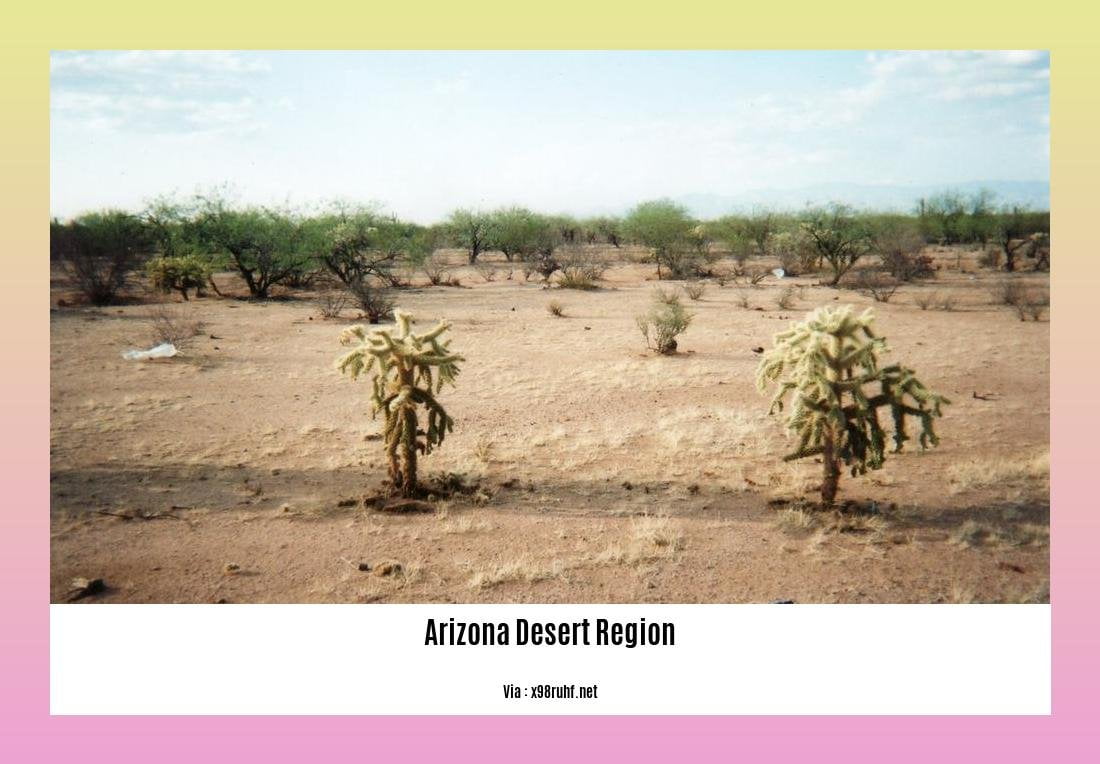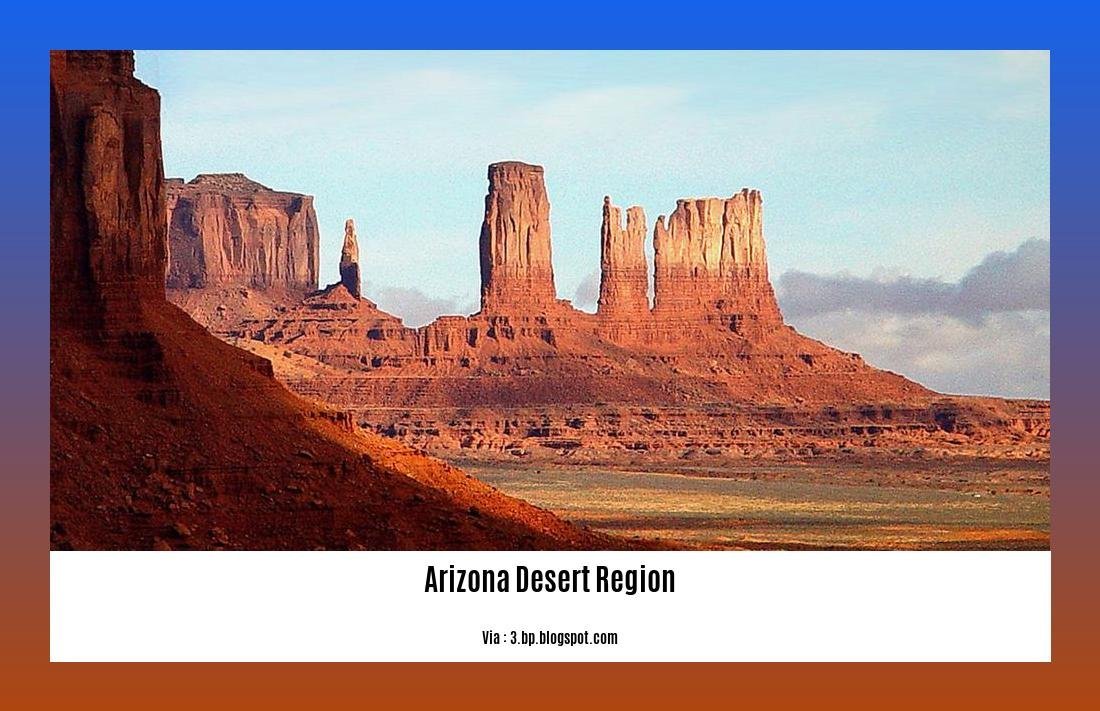The Arizona desert region is a treasure trove of natural wonders, cultural heritage, and breathtaking landscapes. In this article, titled “Exploring the Marvels: Arizona Desert Region Facts Unveiled,” we delve into the fascinating world of this arid paradise. From its diverse ecosystems to its unique wildlife and awe-inspiring geological formations, get ready to embark on an extraordinary journey through the enchanting desert of Arizona. Discover the rich history, fascinating plant and animal adaptations, and the significance of sustainable tourism in preserving this extraordinary desert ecosystem.
Key Takeaways:
- The Great Basin Desert is the last desert in Arizona and receives less than 10 inches of rainfall annually.
- The Sonoran Desert spans the southern half of Arizona and covers about 100,000 square miles.
- The Sonoran Desert is known for its iconic saguaro cactus and is a popular tourist destination.
- Saguaro National Park in the Sonoran Desert showcases thousands of towering saguaro cacti.
- The Sonoran Desert is home to various plant species including ocotillo, creosote bush, and palo verde trees.
- The desert supports diverse wildlife such as the desert tortoise, Gila monster, roadrunner, and javelinas.
- The Sonoran Desert National Monument offers opportunities for hiking, camping, and wildlife viewing.
- The Sonoran Desert has a hot and arid climate with long, extremely hot summers and mild winters.
- Multiple access points and visitor centers provide information and permits for visitors to the Sonoran Desert.
- The Desert Museum in Tucson is a popular attraction that offers educational exhibits about the desert’s ecology.
- The Sonoran Desert offers opportunities for exploration, education, and appreciation of its natural beauty and biodiversity.
Arizona Desert Region Facts

The Arizona desert region is a captivating and diverse ecosystem, renowned for its arid beauty and unique wildlife. Let’s delve into some fascinating facts about this marvelous desert region.
The Sonoran Desert: A Natural Wonder
The Sonoran Desert is the most well-known desert in Arizona, covering approximately 100,000 square miles. This vast expanse is home to various species of plants and animals that have adapted to its challenging climate. One of the iconic features of the Sonoran Desert is the saguaro cactus, which can be seen standing tall in the Saguaro National Park.
Delving Into the Sonoran Desert’s Flora
The Sonoran Desert boasts a rich variety of plant life. Apart from the saguaro cactus, you’ll also come across unique species like the ocotillo, creosote bush, and palo verde trees. These plants have evolved to thrive in the harsh conditions of the desert, showcasing incredible adaptations.
Discovering Desert Wildlife
The Sonoran Desert is teeming with a diverse range of wildlife. Creatures like the desert tortoise, Gila monster, roadrunner, and javelinas call this arid region their home. The desert provides a unique habitat for these animals, allowing them to survive in an environment that may seem inhospitable to some.
Protecting the Sonoran Desert: National Monuments and Preserves
The Sonoran Desert National Monument, established in 2001, plays a crucial role in preserving the desert’s unique ecosystems and biodiversity. This protected area offers opportunities for hiking, camping, and wildlife viewing, allowing visitors to truly immerse themselves in the wonders of this desert realm.
Climate: Surviving the Extreme
The Sonoran Desert’s climate is characterized by long, scorching summers and mild winters. In summer, temperatures can soar to over 100 degrees Fahrenheit, while winters offer relief with temperatures ranging from 40 to 70 degrees Fahrenheit. Surviving in these extreme conditions requires adaptation and resilience.
Embarking on an Adventure: Visit the Sonoran Desert
If you’re captivated by the allure of the Sonoran Desert, there are several access points and visitor centers where you can obtain information and permits for exploration. A must-visit attraction is the Desert Museum in Tucson, which offers educational exhibits and programs that delve into the desert’s unique ecology.
In conclusion, the Arizona desert region, particularly the Sonoran Desert, is a remarkable ecosystem that captivates visitors with its iconic saguaro cacti, diverse plant and animal species, and extreme climate. Exploring this desert region unveils a world of wonder and highlights the importance of preserving and appreciating the natural world around us.
[arizona desert region facts]
Here are some fascinating facts about Argentina!
- Argentina fun facts: Discover unique and exciting tidbits about this vibrant South American country.
- Argentina fun facts culture: Delve into the rich cultural heritage and traditions that make Argentina so captivating.
- Argentina fun facts in Spanish: Learn interesting facts about Argentina in its native language, Spanish.
- Arizona desert facts: Explore the wonders of the Arizona desert and uncover its hidden secrets.
Click on the links above to embark on an exhilarating journey of knowledge and exploration!
Unique Wildlife in the Arizona Desert

The Arizona desert region is not only known for its breathtaking natural beauty but also for its unique and diverse wildlife. From large mammals to small reptiles, the desert is home to a range of fascinating species that have adapted to the arid environment. In this article, we will explore some of the remarkable wildlife found in the Arizona desert.
Exploring the Desert’s Wildlife
The Arizona desert is teeming with a variety of wildlife, each with its own adaptations to survive in this challenging environment. One of the most iconic animals found in the desert is the coyote. These resourceful canines have learned to thrive in the harsh desert conditions, adapting their diet to include rodents, insects, and even fruits and plants.
Another unique mammal found in the Arizona desert is the cougar, also known as the mountain lion. These elusive creatures are skilled hunters and play a vital role in maintaining the balance of the desert ecosystem. While encounters with cougars are rare, their presence reminds us of the diverse wildlife that calls this region home.
In addition to these larger mammals, the Arizona desert is also home to a variety of smaller species that have adapted to the desert’s extreme conditions. Some of these species, like the cactus mouse and the striped skunk, are native to the state and can’t be found widely across the United States.
The desert’s reptile population is equally fascinating, but it’s important to note that some of these species can be dangerous. Arizona is home to the venomous Gila monster and an impressive 14 different species of rattlesnakes. Proper caution should be taken while exploring the desert to avoid any encounters with these creatures.
Desert Discoveries and Natural Beauty
Apart from its unique wildlife, the Arizona desert offers a stunning landscape with its own allure. The region’s vibrant wildflowers bloom during the season, painting the desert with a burst of color and fragrance. It’s a sight that truly captures the resilience of nature in this harsh environment.
The desert climate of Arizona is characterized by hot summers and mild winters, creating the perfect conditions for these extraordinary ecosystems to thrive. The plants and animals found here have evolved to withstand the blazing heat and scarcity of water, showcasing remarkable adaptations that continue to awe and inspire.
Key Takeaways:
- The Arizona desert is home to a diverse range of wildlife, including large mammals like coyotes and cougars, as well as smaller species like cactus mice and striped skunks.
- Some of the unique species found in Arizona are native to the state and not found widely across the United States.
- The desert is also home to dangerous animals, including the venomous Gila monster and 14 different species of rattlesnakes.
- Arizona’s deserts offer breathtaking natural scenery, with vibrant wildflowers during the season.
- The deserts of Arizona have a desert climate characterized by hot summers and mild winters.
- The wildlife and natural beauty of the Arizona desert highlight the importance of sustainable tourism in preserving this extraordinary ecosystem.
Sources:
– Owlcation: 25 Amazing Arizona Desert Animals
– Wildlife Informer: Wild Animals in Arizona
Awe-Inspiring Geological Formations in the Arizona Desert
The Arizona desert is a mesmerizing landscape with awe-inspiring geological formations that have been shaped over millions of years. From towering mountains to deep canyons, the desert region is a testament to the forces of nature. Let’s delve into some of these remarkable formations and uncover the secrets they hold.
The Grand Canyon: A Natural Wonder
No discussion of the Arizona desert’s geological formations would be complete without mentioning the Grand Canyon. The Grand Canyon is undoubtedly one of the most awe-inspiring sights in the world, stretching for 277 miles and reaching depths of over a mile. Its breathtaking beauty and colorful rock layers tell the story of millions of years of geologic history.
Monument Valley: Majestic and Timeless
Another iconic desert formation that will leave you in wonder is Monument Valley. This stunning landscape showcases towering sandstone buttes rising from the desert floor, juxtaposed against a vast, open expanse. Monument Valley has been the backdrop for countless movies and is inseparable from the popular image of the American West.
Meteor Crater: A Window to the Past
Imagine witnessing the impact of a meteorite that struck the Earth over 50,000 years ago. Located east of Flagstaff, Meteor Crater is just that—a colossal crater with a diameter of over 0.7 miles, serving as a reminder of the immense power of celestial events. Exploring the visitor center and peering into this enormous scar on the Earth’s surface is a truly awe-inspiring experience.
Sedona: A Tapestry of Sandstone
The vibrant red rock formations of Sedona create a beautiful tapestry of natural art in the Arizona desert. This unique geological wonderland is dotted with stunning sandstone formations that glow brilliantly in the sunlight. From the towering Cathedral Rock to the famous Bell Rock, Sedona offers countless opportunities for outdoor enthusiasts and nature lovers.
Key Takeaways:
- The Arizona desert is home to awe-inspiring geological formations shaped over millions of years.
- The Grand Canyon, with its colorful rock layers, is a world-renowned natural wonder.
- Monument Valley boasts towering sandstone buttes against a vast desert backdrop.
- Meteor Crater is an enormous scar on the Earth’s surface, created by a meteorite impact thousands of years ago.
- Sedona’s red rock formations create a stunning tapestry of natural art.
Sources:
– The Grand Canyon – National Park Service
– Monument Valley – Navajo Nation Parks & Recreation
Exploring the Marvels: Arizona Desert Region Facts Unveiled
The Importance of Sustainable Tourism in the Arizona Desert
The Arizona desert region is a captivating landscape that boasts unique ecosystems, fascinating wildlife, and awe-inspiring geological formations. As a travel writer and nature enthusiast, I have delved deep into the arid beauty of this region and have come to appreciate its fragility and the need for sustainable tourism to preserve its extraordinary ecosystem.
Sustainable tourism in desert areas is crucial for combatting desertification and poverty while allowing tourism to play a positive role. The desert environment is fragile, and maintaining its sustainability presents a critical challenge. By adopting sustainable practices, we can ensure that future generations can continue to enjoy the stunning beauty of the Arizona desert while preserving its delicate balance.
Arizona, known for its outdoor adventure opportunities, offers a range of activities that allow visitors to immerse themselves in the wonders of the desert. From hiking and mountain biking to skiing, cave exploration, and water sports, there is something for everyone. These activities not only provide enjoyment but also foster a connection with nature and promote a sense of environmental stewardship.
In addition to its outdoor adventures, Arizona boasts a rich history of American Indian and Old West culture, making it a destination for arts and culture enthusiasts. The state’s public lands, including campgrounds, parks, monuments, lakes, and wilderness areas, are major tourism assets that contribute to the region’s allure.
Sustainable lodging, natural and cultural tourism, and the preservation of public lands are all vital aspects of sustainable tourism in Arizona. By prioritizing sustainable lodging options, such as eco-friendly resorts and hotels, we can minimize our ecological footprint while still enjoying comfortable accommodations. Emphasizing natural and cultural tourism allows us to appreciate and protect the unique heritage of the Arizona desert, all while supporting local economies.
Arizona is home to numerous archaeological sites, national historic landmarks, and state, and national parks. These sites offer invaluable educational and recreational opportunities for visitors while promoting the importance of preserving our natural and cultural heritage. By encouraging sustainable tourism practices, we can ensure that these sites remain accessible and protected for future generations to enjoy.
Sustainable tourism in extreme environments like deserts is a topic of immense interest and importance. Studies have been conducted to understand the impact and significance of sustainability in these areas. It is crucial that we continue to explore and implement sustainable practices in the Arizona desert to mitigate the potential negative effects on its delicate ecosystems.
Key Takeaways:
- Sustainable tourism in the Arizona desert is vital for preserving the fragile ecosystem and combating desertification and poverty.
- By engaging in outdoor adventure activities and embracing the state’s cultural offerings, visitors can form a deep connection with the Arizona desert.
- Sustainable lodging, natural and cultural tourism, and the preservation of public lands are critical aspects of sustainable tourism in the region.
- Arizona’s archaeological sites, national historic landmarks, and state and national parks offer both recreational and educational opportunities.
- Studies have been conducted to understand the impact of sustainability in desert environments, highlighting the importance of incorporating sustainable practices in the Arizona desert.
Citations:
– UNWTO. Sustainable Development of Tourism in Deserts – Guide for Decision Makers
– Frommer’s: Sustainable Travel & Ecotourism in Arizona
FAQ
Q1: How much rainfall does the Great Basin Desert in Arizona receive annually?
A1: The Great Basin Desert in Arizona receives less than 10 inches of rainfall annually.
Q2: What are some notable plant species found in the Sonoran Desert?
A2: Some notable plant species found in the Sonoran Desert include saguaro cacti, ocotillo, creosote bush, and palo verde trees.
Q3: What are some unique animal species found in the Sonoran Desert?
A3: Some unique animal species found in the Sonoran Desert include the desert tortoise, Gila monster, roadrunner, and javelinas.
Q4: What is the Sonoran Desert National Monument?
A4: The Sonoran Desert National Monument is a protected area established in 2001 that preserves a large portion of the Sonoran Desert and its diverse ecosystems. It offers opportunities for hiking, camping, and wildlife viewing.
Q5: What is the climate like in the Sonoran Desert?
A5: The Sonoran Desert has a hot and arid climate. Summers are long and extremely hot, with temperatures often exceeding 100 degrees Fahrenheit, while winters are mild, with temperatures ranging from 40 to 70 degrees Fahrenheit.









